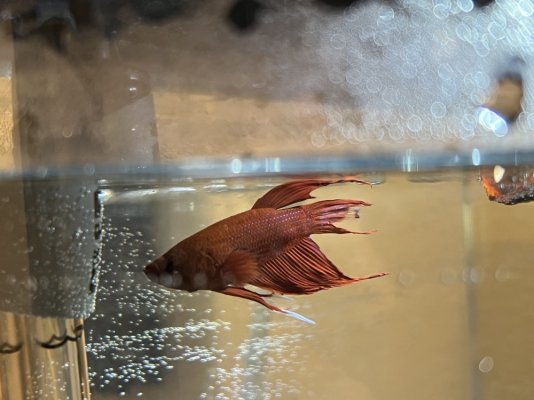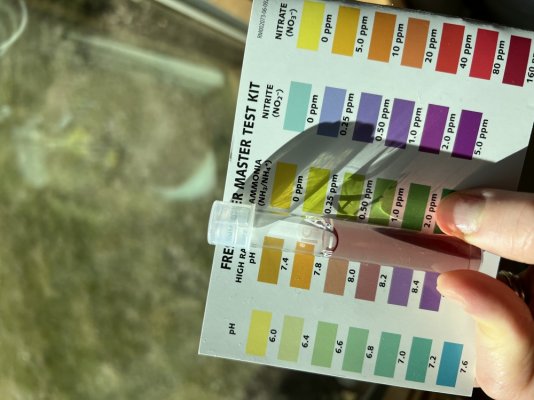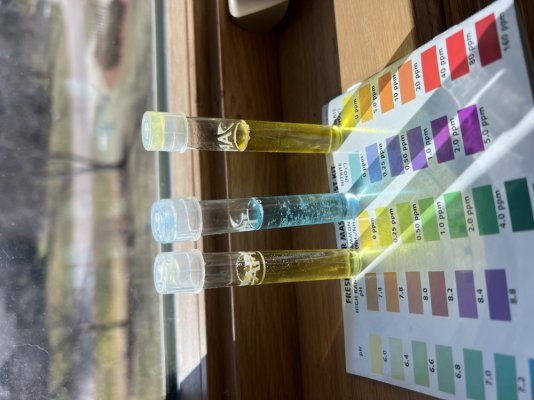Hello, folks.
I am relatively new to the hobby (coming up on a year), and have a male betta (Bob) that keeps getting fungus. When I first introduced him to my 10-gallon cycled tank about two months ago, I added him along with 5 WCMMs, who ended up being nippy and stressing him out to the point of him developing fin rot.
I removed the WCMMs into my larger cold-water tank and successfully treated my betta with aquarium salt and Bettafix over the course of a week, and he was active and doing well until a couple of days ago, when he developed what appears to be a fungus. It's a whitish, cloudy-looking slime on his back fins.
I immediately moved him into a 3.5-gallon quarantine tank with a heater and sponge filter set to a gentle setting. I dosed the tank with aquarium salt, KanaPlex, Bettafix, and today did a Methylene Blue dip for 10 seconds, as the growth seemed to have grown a bit overnight.
The water test came back with the following parameters (ammonia = 0, nitrites = 0, nitrates = 0, temp = 75 degrees F, pH = 8.2). While I recognize that my pH is a bit high, it's been stable every time I've tested the tank. I can't account for why it's so much higher than my tap water (7.2), so if anybody has insights on that, I'd love to get it lowered.
The tank is a 10-gallon planted and has been set up for 3 months. I cycled it fish-free for a month before adding in the first batch of inhabitants: the betta, 5 WCMM, two nerite snails, and 2 Amanos. I have since removed the minnows as mentioned and added in 8 cherry shrimp.
The tank has a sizable cholla log (large enough for Bob to swim through), a ceramic cave structure, and a floating Betta log as the primary decorations, along with a number of plants. I'm using Fluval plant and shrimp substrate under a layer of white sand. I do add Wonder Shells into the tank monthly for my shrimp, which might be contributing to the pH being higher, not sure.
I am using a this Hygger sponge filter in the main tank.
I do weekly water changes where I change 30% of the water. I always condition the water with SeaChem Prime, rest for 1 day, and then add it into the tank following vacuuming.
Recently (about three weeks ago), I added in the 8 RCSs, but he seemed to ignore them, patrolling his tank as usual. I did get a new shrimp-friendly fertilizer about 10 days ago, and I've dosed at half the dosage for the past week. It's this one, and I was testing water parameters daily to ensure it didn't cause an ammonia spike in the tank.
Bob eats only Omega One seafood betta pellets. I have tried feeding him both freeze-dried and frozen daphnia and bloodworms, but he has no interest, and they make quite a big mess in the tank, so I've stopped trying. He seems to like his pellets quite a lot, though, and was a hearty eater prior to this fungus.
Any insights would be appreciated; it's super frustrating, as it feels like I'm just constantly researching this fish setup and don't have any answers as to why it's not working out for poor Bob.
I am relatively new to the hobby (coming up on a year), and have a male betta (Bob) that keeps getting fungus. When I first introduced him to my 10-gallon cycled tank about two months ago, I added him along with 5 WCMMs, who ended up being nippy and stressing him out to the point of him developing fin rot.
I removed the WCMMs into my larger cold-water tank and successfully treated my betta with aquarium salt and Bettafix over the course of a week, and he was active and doing well until a couple of days ago, when he developed what appears to be a fungus. It's a whitish, cloudy-looking slime on his back fins.
I immediately moved him into a 3.5-gallon quarantine tank with a heater and sponge filter set to a gentle setting. I dosed the tank with aquarium salt, KanaPlex, Bettafix, and today did a Methylene Blue dip for 10 seconds, as the growth seemed to have grown a bit overnight.
The water test came back with the following parameters (ammonia = 0, nitrites = 0, nitrates = 0, temp = 75 degrees F, pH = 8.2). While I recognize that my pH is a bit high, it's been stable every time I've tested the tank. I can't account for why it's so much higher than my tap water (7.2), so if anybody has insights on that, I'd love to get it lowered.
The tank is a 10-gallon planted and has been set up for 3 months. I cycled it fish-free for a month before adding in the first batch of inhabitants: the betta, 5 WCMM, two nerite snails, and 2 Amanos. I have since removed the minnows as mentioned and added in 8 cherry shrimp.
The tank has a sizable cholla log (large enough for Bob to swim through), a ceramic cave structure, and a floating Betta log as the primary decorations, along with a number of plants. I'm using Fluval plant and shrimp substrate under a layer of white sand. I do add Wonder Shells into the tank monthly for my shrimp, which might be contributing to the pH being higher, not sure.
I am using a this Hygger sponge filter in the main tank.
I do weekly water changes where I change 30% of the water. I always condition the water with SeaChem Prime, rest for 1 day, and then add it into the tank following vacuuming.
Recently (about three weeks ago), I added in the 8 RCSs, but he seemed to ignore them, patrolling his tank as usual. I did get a new shrimp-friendly fertilizer about 10 days ago, and I've dosed at half the dosage for the past week. It's this one, and I was testing water parameters daily to ensure it didn't cause an ammonia spike in the tank.
Bob eats only Omega One seafood betta pellets. I have tried feeding him both freeze-dried and frozen daphnia and bloodworms, but he has no interest, and they make quite a big mess in the tank, so I've stopped trying. He seems to like his pellets quite a lot, though, and was a hearty eater prior to this fungus.
Any insights would be appreciated; it's super frustrating, as it feels like I'm just constantly researching this fish setup and don't have any answers as to why it's not working out for poor Bob.



